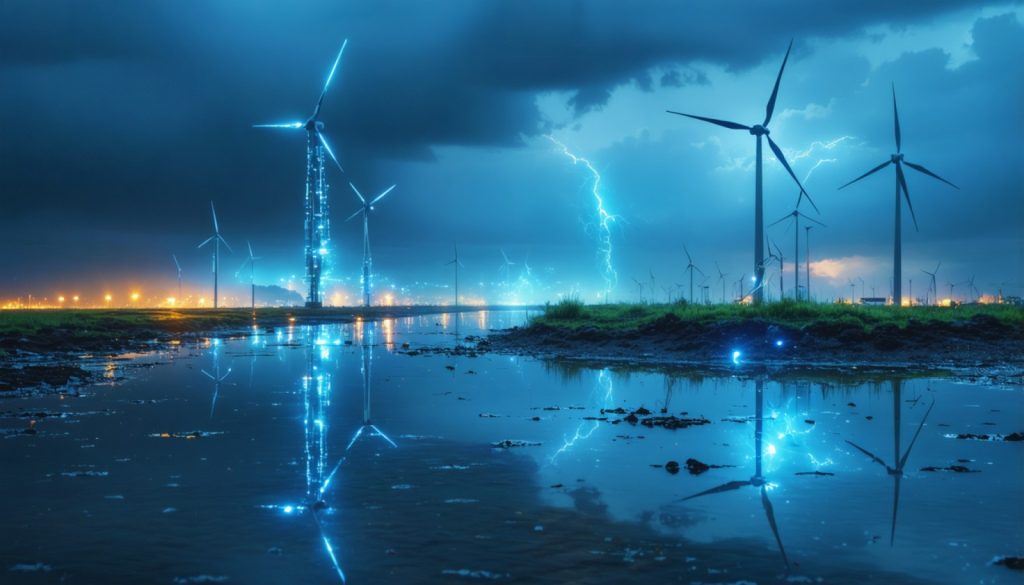
- The AI Energy Council, an initiative by the UK government, unites tech and energy leaders to integrate AI with sustainable energy practices.
- The Council aims to align renewable energy sources with AI’s power demands, boosting innovation and economic growth in the UK.
- AI Growth Zones are being established to support tech investments and create local jobs by providing significant power capacity.
- The focus is on combining renewables and nuclear energy to maintain ecological balance while advancing digital progress.
- The initiative seeks to securely incorporate AI into the UK’s energy networks, ensuring intelligent and efficient energy consumption.
- Potential reforms could release large energy capacities, enabling infrastructure projects and symbiotic growth of AI and clean energy.
- Success depends on harnessing power intelligently, aiming for the UK to lead globally in AI-driven sustainable development.
Like the dawn of the steam engine or the discovery of electricity, the age of Artificial Intelligence (AI) is upon us, bringing profound changes to society’s framework. Today, an unprecedented alliance of tech behemoths and energy titans gathers in Whitehall to forge a path forward, orchestrating the delicate dance between energy resources and AI ambitions.
The newly launched AI Energy Council, a brainchild of the UK government, is more than just a meeting of minds; it’s the vanguard of a visionary cross-industry initiative. Picture it: the gleaming boardrooms where top executives from Microsoft, Google, ARM, and Amazon converge with the energy giants like National Grid, EDF, and Scottish Power. They’re powered by a common goal, igniting an era of growth and opportunity, bolstered by sustainable practices that would make a science fiction writer proud.
The council, co-chaired by the Technology and Energy Secretaries, busies itself with answering a pressing question: how can one of the oldest industries support one of the newest technologies? The UK’s clean energy superpower mission aims to answer by dovetailing renewable energy sources with AI’s insatiable thirst for power, fostering not only innovation but also economic surges the likes of which the nation has long aspired to achieve.
Across the country, dedicated AI Growth Zones rise like digital cathedrals, each strategically positioned to access a colossal 500MW of power. This staggering figure, enough to illuminate nearly two million homes, beckons tech investments like moths to a flame, promising local jobs and revitalization in regions that have been patiently waiting for their renaissance.
At this epicenter of change is the unwavering focus on sustainable practices. The council plans to explore the integration of renewables and nuclear options to make sure that digital progress does not come at the expense of ecological balance. The avatars of innovation are now charged with optimizing energy efficiency within the towering data centers, turning the mechanical hum of servers into a symphony of sustainability.
Yet, the council’s vision extends even further. They stand poised to ensure the secure adoption of AI across the UK’s energy networks, a task that requires meticulous coordination and futuristic insight. This harmonization is pivotal, where AI isn’t just a pretender sitting at the table of energy consumption but rather a revolutionary force that reshapes the energy grid itself.
It’s not just empty talk. With reforms from partners like Ofgem in the pipeline, the promise to release more than 400GW of capacity from the nation’s energy queues hints at a transformative leap. This could unlock a deluge of infrastructure projects, heralding a new era where AI and clean energy not only coexist but thrive symbiotically.
The real takeaway? As the gears of industry keep turning, the UK positions itself not just as a player on the global stage but potentially as a leader. Success hinges not just on how much power it can produce but how intelligently that power can be harnessed to realize ambitions that were once dreams, glittering on the horizon.
This inaugural meeting isn’t merely about laying foundations. It’s about conjuring a future where innovation hugs sustainability, driving the UK into a golden age powered by both machines and responsibility. With the lungs of technology and the heartbeat of clean energy, the vision is clear: power AI responsibly to unleash prosperity.
The Next Industrial Revolution: How AI and Clean Energy Shape Our Future
Exploring the Integration of AI and Renewable Energy
The convergence of Artificial Intelligence (AI) and clean energy represents more than just a technological advancement; it’s a transformative shift reminiscent of the industrial revolutions of the past. Let’s delve deeper into the facets of this revolution that were not fully explored in recent discussions.
How-To: Steps for Integrating AI with Renewable Energy
1. Assess Energy Demands: AI can predict energy consumption patterns, allowing grid operators to optimize resource allocation effectively. By analyzing historical data, AI algorithms can forecast peak demand and adjust energy dispatch accordingly.
2. Deploy Smart Grids: Upgrading to smart grids with AI capabilities enables real-time monitoring and adaptive responses to changes in energy demand and supply, improving efficiency and reliability.
3. Optimize Data Centers: Implement AI-driven cooling and power management systems within data centers to reduce energy consumption significantly. AI can identify inefficiencies and adjust operations in real-time for maximum energy savings.
4. Enhance Energy Storage Systems: AI can enhance battery storage systems by predicting charging and discharging cycles, ensuring that renewable energy can be stored efficiently and used when needed.
Real-World Use Cases
– Google’s AI for Wind Energy: Google has employed AI to predict wind patterns 36 hours in advance, enabling better scheduling of electricity supply from its wind farms, resulting in a 20% increase in value.
– Smart Cities Initiative: Cities like Singapore are using AI to manage traffic lights, street lighting, and public transportation, drastically reducing energy consumption and cutting costs.
Industry Trends and Market Forecasts
– Rising Investment: According to a report by the International Renewable Energy Agency (IREA), global investment in AI-integrated renewable energy systems is expected to grow by 12% annually from 2023 to 2030.
– Job Creation: The AI and renewable energy sectors combined could create over 10 million new jobs worldwide by 2030, particularly in regions transitioning from traditional energy sources to renewables.
Controversies and Limitations
– Data Privacy: The use of AI in energy systems raises concerns about data privacy and security. Unauthorized access to AI-managed systems could lead to energy disruption, making robust cybersecurity measures essential.
– High Energy Consumption of AI: Ironically, while AI can optimize energy use, training AI models requires significant computational power. Balancing AI’s energy consumption with its optimization benefits is crucial.
Features, Specs & Pricing
– AI Energy Management Systems: Prices vary based on capacity and scale, with initial setups costing from $50,000 to several million dollars for large-scale implementations.
Security and Sustainability
– Robust Security Protocols: Implementing advanced encryption and AI-driven anomaly detection can protect energy systems from cyber threats.
– Sustainable Practices: The emphasis on sourcing at least 50% of operational power from renewable sources ensures that AI initiatives do not compromise environmental goals.
Insights & Predictions
– Decentralized Energy Systems: AI’s role in facilitating peer-to-peer energy trading could democratize energy markets, allowing consumers to trade surplus energy.
– Increased Resilience: AI technologies are predicted to enhance the resilience of the energy grid against climate-induced disruptions, cushioning economies from potential energy crises.
Conclusion and Quick Tips
To harness the full potential of AI and renewable energy, stakeholders should focus on the following:
– Invest in AI Talent: Develop expertise in AI technologies through education and training programs to drive innovation.
– Prioritize Cybersecurity: Ensure robust cybersecurity measures are in place to protect AI-managed energy systems from potential threats.
– Support Policy Reforms: Advocate for supportive policies that encourage the adoption of AI in energy management, ensuring a sustainable and secure future.
For More Information
Stay updated with the latest in AI and energy by visiting authoritative sources such as the Google and Microsoft. These tech leaders are at the forefront of this innovative transformation.



